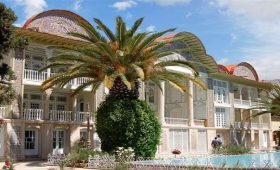Naqsh-e Rajab: A Glorious Remnant of the Sassanian Empire
Introduction Naqsh-e Rajab, located near the ancient city of Persepolis and the famous Naqsh-e Rostam necropolis, is one of the most significant and well-preserved historical sites from the Sassanian era. It contains four elaborate rock reliefs that depict royal ceremonies and important figures from the Sassanian dynasty. These carvings provide valuable insights into the art, culture, and political landscape of one of the greatest pre-Islamic Persian empires.
Historical Background The Sassanian Empire, which ruled Persia from 224 to 651 AD, was known for its sophisticated governance, artistic advancements, and military prowess. Naqsh-e Rajab was created during the early Sassanian period and primarily served to immortalize the grandeur of its rulers. The site is believed to have been an important ceremonial location, where major events such as coronations were commemorated through intricate carvings on the limestone cliffs.
Location and Accessibility Naqsh-e Rajab is situated about 3 kilometers north of Persepolis and just a short distance from Naqsh-e Rostam in the province of Fars, Iran. The site is easily accessible by road and is a popular stop for tourists exploring the ancient remnants of Persian civilization. Due to its proximity to these other major historical sites, Naqsh-e Rajab is often visited in conjunction with a tour of Persepolis and Naqsh-e Rostam.
The Rock Reliefs of Naqsh-e Rajab Naqsh-e Rajab consists of four distinct rock reliefs, each showcasing a unique aspect of Sassanian royal life. These carvings are among the finest examples of Sassanian bas-relief art, demonstrating detailed craftsmanship and a deep understanding of perspective and composition.
- The Coronation of Ardashir I
The most famous relief at Naqsh-e Rajab depicts the coronation of Ardashir I (224–241 AD), the founder of the Sassanian Empire. The scene captures the moment when the deity Ahura Mazda bestows the royal diadem upon Ardashir I, symbolizing divine legitimacy. The relief also features attendants and courtiers, further emphasizing the grandeur of the occasion. - Shapur I’s Royal Procession
Another significant relief portrays Shapur I (240–270 AD), one of the most powerful Sassanian kings. The carving showcases Shapur I seated on horseback, surrounded by noblemen and officials. His distinctive crown and regal attire distinguish him as a revered ruler. Shapur I is well known for his military victories against the Roman Empire, and this relief stands as a testament to his strength and authority. - Shapur I with Courtiers
A third relief presents a more intimate view of Shapur I, where he is depicted standing alongside his officials and courtiers. This detailed carving highlights the hierarchical structure of the Sassanian court and the significance of royal ceremonies. The intricate details in the facial expressions, clothing, and postures showcase the high level of artistry in Sassanian stone reliefs. - The High Priest Kartir
The fourth relief at Naqsh-e Rajab is unique as it features Kartir, a high-ranking Zoroastrian priest. Unlike the other reliefs, which focus on kings and their courtly affairs, this depiction signifies the deep connection between religion and the Sassanian state. Kartir played a crucial role in shaping Zoroastrian policies during the empire’s height, and his representation at Naqsh-e Rajab highlights his influence.
Symbolism and Artistic Techniques Naqsh-e Rajab’s reliefs are not just depictions of historical events; they also carry profound symbolic meanings. The handing of the diadem from Ahura Mazda to the kings signifies divine approval and legitimacy. The presence of courtiers, noblemen, and priests illustrates the hierarchical and structured nature of Sassanian governance.
From an artistic perspective, the reliefs showcase advanced techniques in depth representation, realistic human proportions, and detailed ornamentation in clothing and crowns. The Sassanian sculptors demonstrated remarkable skill in creating a sense of movement and grandeur within the rigid medium of rock carvings.
Cultural and Historical Significance Naqsh-e Rajab serves as an invaluable historical source that helps researchers and historians understand the ideological and political landscape of the Sassanian Empire. These carvings provide evidence of how rulers legitimized their authority, the role of religion in governance, and the visual language used to communicate power and prestige.
Additionally, the site is an important part of Iran’s cultural heritage, attracting thousands of visitors each year who come to admire the artistic brilliance of the ancient Persian civilization.

